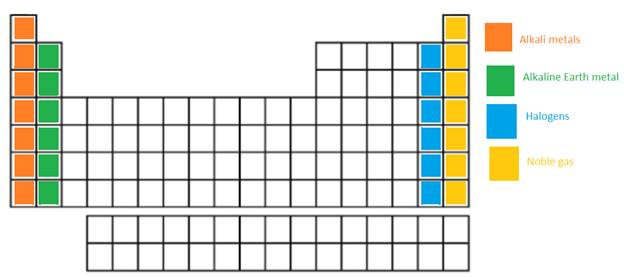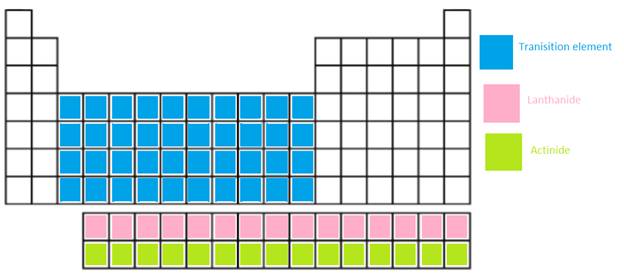
(a)
Interpretation:
The alkali metals, alkaline earth metals, halogen and the Noble gases in the periodic table need to be labeled.
Concept introduction:
Element is the basic unit of any substance which can combine with same or different elements to form molecules and compounds. Elements are composed of the same type of atoms therefore they exhibit unique physical and chemical properties.
The
(a)
Answer to Problem 3E

Explanation of Solution
In the long form of periodic table; alkali metals, alkaline earth metals, halogen and the Noble gases are name of certain groups. In periodic table, the vertical columns are called as groups.
Alkali metal = The IA or 1st group is named as alkali metals as these metallic elements form alkaline oxides and hydroxides.
Alkaline earth metals = The IIA or 2nd group is named as Alkaline earth metals as these metallic elements form alkaline compounds and are also found in Earth crust.
Halogens = It is VIIA or 17th group of the periodic table. They are non-metallic elements.
Noble gases = These elements are placed in group 18th or also called as zero group. They are non-reactive and monoatomic gases.
The position of these elements in the periodic table is as follows:

(b)
Interpretation:
The main group elements, transition metal, Lanthanide and actinide needs to be shown in the periodic table.
Concept introduction:
Element is the basic unit of any substance which can combine with same or different elements to form molecules and compounds. Elements are composed of same type of atoms therefore they exhibit unique physical and chemical properties.
The chemical reaction of two or more elements leads to the formation of new molecules and compounds.
(b)
Answer to Problem 3E

Explanation of Solution
In periodic table, the vertical columns are called as groups and horizontal rows are period.
Transition metal =
Lanthanide = These are the f-block elements which are placed at the bottom of main body. It is a series of 14 elements where electrons are filled in 4f orbitals.
Actinide = These are the f-block elements which are placed at the bottom of main body. It is series of 14 elements where electrons are filled in 5f orbitals.
The position of these elements in the periodic table is given below:

Chapter U1 Solutions
Living By Chemistry: First Edition Textbook
Additional Science Textbook Solutions
CHEMISTRY-TEXT
General, Organic, and Biological Chemistry (3rd Edition)
Chemistry & Chemical Reactivity
Chemistry & Chemical Reactivity
Organic Chemistry
Introductory Chemistry (5th Edition) (Standalone Book)
 ChemistryChemistryISBN:9781305957404Author:Steven S. Zumdahl, Susan A. Zumdahl, Donald J. DeCostePublisher:Cengage Learning
ChemistryChemistryISBN:9781305957404Author:Steven S. Zumdahl, Susan A. Zumdahl, Donald J. DeCostePublisher:Cengage Learning ChemistryChemistryISBN:9781259911156Author:Raymond Chang Dr., Jason Overby ProfessorPublisher:McGraw-Hill Education
ChemistryChemistryISBN:9781259911156Author:Raymond Chang Dr., Jason Overby ProfessorPublisher:McGraw-Hill Education Principles of Instrumental AnalysisChemistryISBN:9781305577213Author:Douglas A. Skoog, F. James Holler, Stanley R. CrouchPublisher:Cengage Learning
Principles of Instrumental AnalysisChemistryISBN:9781305577213Author:Douglas A. Skoog, F. James Holler, Stanley R. CrouchPublisher:Cengage Learning Organic ChemistryChemistryISBN:9780078021558Author:Janice Gorzynski Smith Dr.Publisher:McGraw-Hill Education
Organic ChemistryChemistryISBN:9780078021558Author:Janice Gorzynski Smith Dr.Publisher:McGraw-Hill Education Chemistry: Principles and ReactionsChemistryISBN:9781305079373Author:William L. Masterton, Cecile N. HurleyPublisher:Cengage Learning
Chemistry: Principles and ReactionsChemistryISBN:9781305079373Author:William L. Masterton, Cecile N. HurleyPublisher:Cengage Learning Elementary Principles of Chemical Processes, Bind...ChemistryISBN:9781118431221Author:Richard M. Felder, Ronald W. Rousseau, Lisa G. BullardPublisher:WILEY
Elementary Principles of Chemical Processes, Bind...ChemistryISBN:9781118431221Author:Richard M. Felder, Ronald W. Rousseau, Lisa G. BullardPublisher:WILEY





